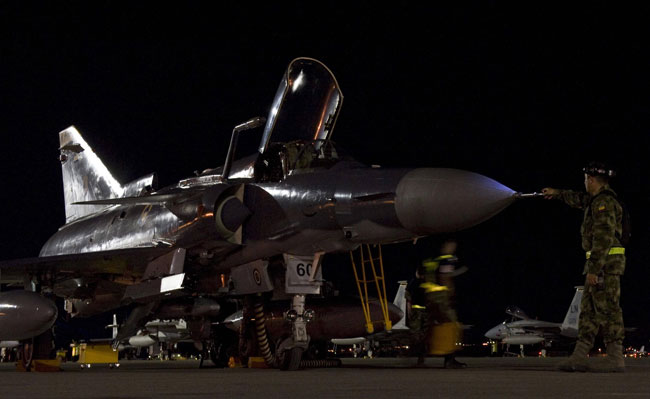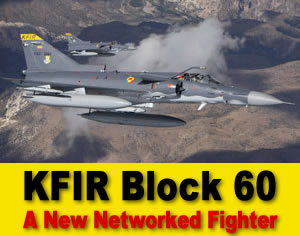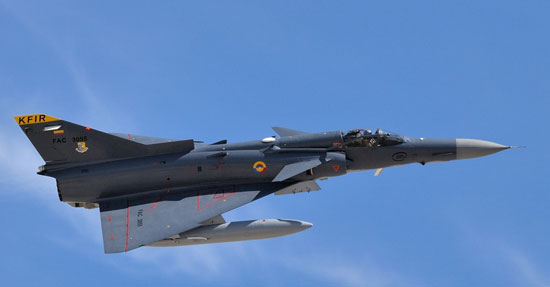
Israel Aerospace Industries (IAI) is offering a modernized version of its 1970 era delta-winged Kfir Mach 2+ fighter aircraft. Equipped with advanced avionics and mission systems that, the IAI claims its old fighter jet could rank in the same class of contemporary ‘fourth generation’ fighter jets. According to sources at IAI, the company can deliver up to 50 Kfirs, configured to the newest ‘Block 60’ standard, utilizing airframes retired from IAF service in the 1990s. These aircraft were mothballed in the southern Negev desert, and are in good condition for refurbishment. Israel has offered these modernized fighter jet to Bulgaria, addressing Sofia’s planning to replace its MiG-21s and MiG-29s with western-compatible fighter jets.[nonmember]
Subscribe to Defense-Update to get the full version of this article[/nonmember]
Bulgaria is interested in buying 10 ‘pre owned’ fighter jets, optimizing them to fulfill combat missions with the NATO alliance. Among the alternatives evaluated by Bulgaria is the procurement of nine used F-16 Block 15s from Portugal, at a cost of $464 million; purchasing Eurofighter Typhoon fighter jets from the Italian Air Force surplus would cost even more. According to IAI, the acquisition of Kfir Block 60 from would cost a third of that price. Bulgaria was also evaluating a Swedish proposal to buy new Gripen fighter jets from Saab.
[ismember]“The Kfir was designed to be a tough fighter jet, well built and ‘young in spirit’ – the Kfirs we are selecting for refurbishment logged only few hundred flight hours, their structure is intact, without cracks or fatigue.” Lahav Division general manager Yosef Melamed told Defense-Update, “When a customer picks these fighters we activate an assembly line where we practically remanufacture the aircraft.” He adds; as part of their return to flying status these jets are totally stripped down, rebuilt, re-wired and re-equipped with modern systems. “As the original manufacturer of the plane, IAI guarantee these refurbished planes can fly 8,000 hours, which, under normal operational tempo could last for up to 40 years” Melamed explained.
A critical factor in the Kfir Block 60 mission efficiency is the aerial refueling capability and airborne datalink support. “Networking is an important element in the modernization of an air force, in the past we upgraded avionics, and complete aircraft, now we are offering an upgrade to a complete fleet of aircraft – enabling members in a formation or even larger groups to share information, targets and situational picture, to assist and support each other in targeting, identification and engagement.” Melamed explains.
The latest configuration, designated Kfir Block 60 turns the Kfir into a ‘4th Generation’ fighter. It is based on the Colombian Kfir C10 single-seat version, with few improvements – the most notable is the installation of Elta EL/M-2052 Active Electronic Scan Array (AESA) replacing the EL/M-2032 mechanical scanning antennae. These radars can simultaneously track 64 targets, engaging selected targets from Beyond Visual Range (BVR) with Derby radar guided missiles. In addition, the radar also supports air-to-surface operating modes including SAR mapping and I-SAR, particularly useful for long-range targeting of naval surface targets. The use of Litening targeting and reconnaissance pods and precision-guided weapons, such as laser-guided bombs or EO-guided weapons further enhances the Kfir’s operational capabilities.
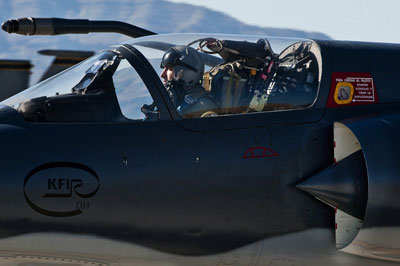
Another new feature of the Kfir C10, C12 and Block 60 is the clear frameless canopy, improving pilot visibility in the forward section. Python V air/air missiles are also supported, cued by the pilot’s line of sight using helmet-mounted display. Tested against Su-30 fighter jets, those latest generation Kfirs equipped with EL/M-2032 radars proved superior in head-on engagement, given their low radar cross section (RCS) and first look-first shoot of BVR missiles. This advantage was particularly important where Kfirs could engage targets at long range, while keeping a tight formation, allocating targets from single radar over the formation datalink. Such techniques are currently developed for the Fifth Generation F-35 and F-22s.
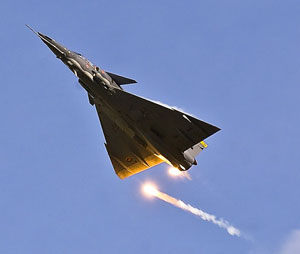
The claims made by IAI are not theoretical. Participating in the Red Flag combat exercise in July 2012, Colombian Kfirs performed all their ground attack missions and also engaged ‘enemy’ fighters in air combat, claiming eight kills (7 F-16s, one F-15).
The successful completion of the Colombian sale motivated IAI to offer the Kfirs to other air forces. The Kfir’s main advantage is the low acquisition cost, and long life cycle, compared to procurement of other refurbished or new fighter jets. Based on the experience gained through years of operational use, IAI is also emphasizing the high reliability and low operating cost, compared to equivalent used fighter jets. The acquisition cost of the Kfir Block 60 would be around US$20 million, including the avionics and weapons – about a third of the cost of an upgraded, modern second-hand single-engine jet fighter, and its operating cost would be about 25 percent of an equivalent fourth generation fighter jet.[/ismember]

The Kfir Block 60 offers a robust and versatile Mach 2+ multi-role jet fighter, carrying 5.5 tons payloads on nine hard-points under the wings and fuselage. The weaponry is enhanced to include Python 5 and Derby. Kfir Block 60 has also completed the integration of RAFAEL Spice autonomous guided weapon, (second platform offering that capability, after the F-16). Conforming to NATO standards, Kfir Block 60 supports Link-16 datalink protocol. The aircraft has combat radius of 1,000 km (540 nm) unrefueled. With refueling the aircraft can fly to a range of 1,100 nm.
Melamed claims Lahav can deliver the first Kfir Block 60 within 12 months after receiving the an order, at roughly a third of the cost of other fighter jets with similar capabilities. This assessment is based on the experience IAI Lahav has gained processing over 2500 aircraft, upgrading earlier Kfir, F-4E, F-16, A-4M, MiG-21, MiG-27, MiG-29 and Su-22. “At times where air forces are seeking cost savings, without degrading operational capabilities, the upgraded Kfir has demonstrated superior performance and reliability in operational use and combat exercises.” Melamed concludes.
